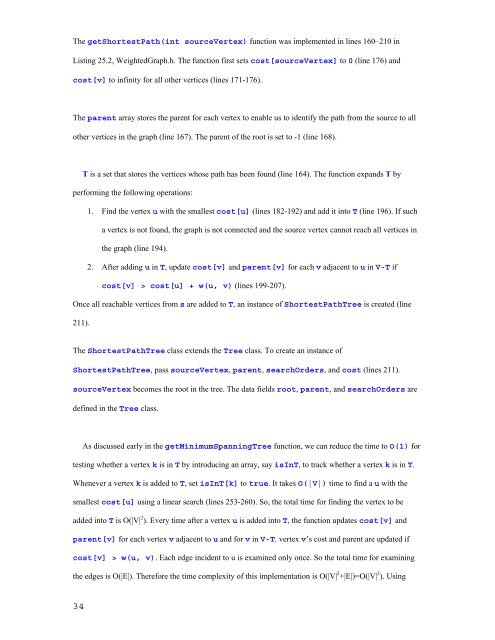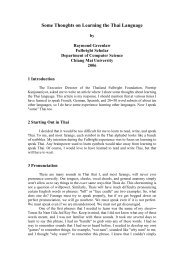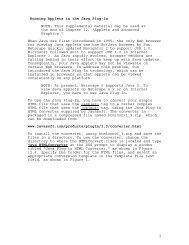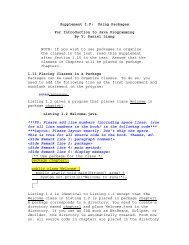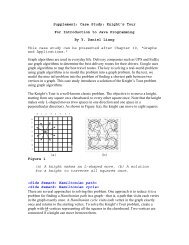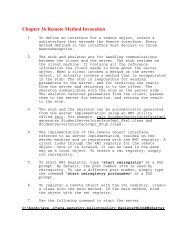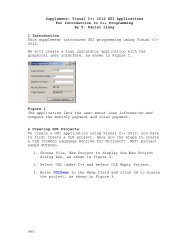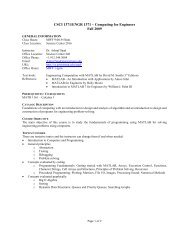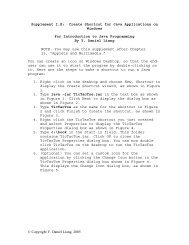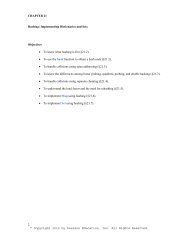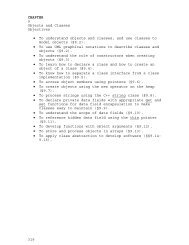CHAPTER 25 Weighted Graphs and Applications Objectives ⢠To ...
CHAPTER 25 Weighted Graphs and Applications Objectives ⢠To ...
CHAPTER 25 Weighted Graphs and Applications Objectives ⢠To ...
You also want an ePaper? Increase the reach of your titles
YUMPU automatically turns print PDFs into web optimized ePapers that Google loves.
The getShortestPath(int sourceVertex) function was implemented in lines 160–210 in<br />
Listing <strong>25</strong>.2, <strong>Weighted</strong>Graph.h. The function first sets cost[sourceVertex] to 0 (line 176) <strong>and</strong><br />
cost[v] to infinity for all other vertices (lines 171-176).<br />
The parent array stores the parent for each vertex to enable us to identify the path from the source to all<br />
other vertices in the graph (line 167). The parent of the root is set to -1 (line 168).<br />
T is a set that stores the vertices whose path has been found (line 164). The function exp<strong>and</strong>s T by<br />
performing the following operations:<br />
1. Find the vertex u with the smallest cost[u] (lines 182-192) <strong>and</strong> add it into T (line 196). If such<br />
a vertex is not found, the graph is not connected <strong>and</strong> the source vertex cannot reach all vertices in<br />
the graph (line 194).<br />
2. After adding u in T, update cost[v] <strong>and</strong> parent[v] for each v adjacent to u in V-T if<br />
cost[v] > cost[u] + w(u, v) (lines 199-207).<br />
Once all reachable vertices from s are added to T, an instance of ShortestPathTree is created (line<br />
211).<br />
The ShortestPathTree class extends the Tree class. <strong>To</strong> create an instance of<br />
ShortestPathTree, pass sourceVertex, parent, searchOrders, <strong>and</strong> cost (lines 211).<br />
sourceVertex becomes the root in the tree. The data fields root, parent, <strong>and</strong> searchOrders are<br />
defined in the Tree class.<br />
As discussed early in the getMinimumSpanningTree function, we can reduce the time to O(1) for<br />
testing whether a vertex k is in T by introducing an array, say isInT, to track whether a vertex k is in T.<br />
Whenever a vertex k is added to T, set isInT[k] to true. It takes O(|V|) time to find a u with the<br />
smallest cost[u] using a linear search (lines <strong>25</strong>3-260). So, the total time for finding the vertex to be<br />
added into T is O(|V| 2 ). Every time after a vertex u is added into T, the function updates cost[v] <strong>and</strong><br />
parent[v] for each vertex v adjacent to u <strong>and</strong> for v in V-T. vertex v’s cost <strong>and</strong> parent are updated if<br />
cost[v] > w(u, v). Each edge incident to u is examined only once. So the total time for examining<br />
the edges is O(|E|). Therefore the time complexity of this implementation is O(|V| 2 +|E|)=O(|V| 2 ). Using<br />
34


